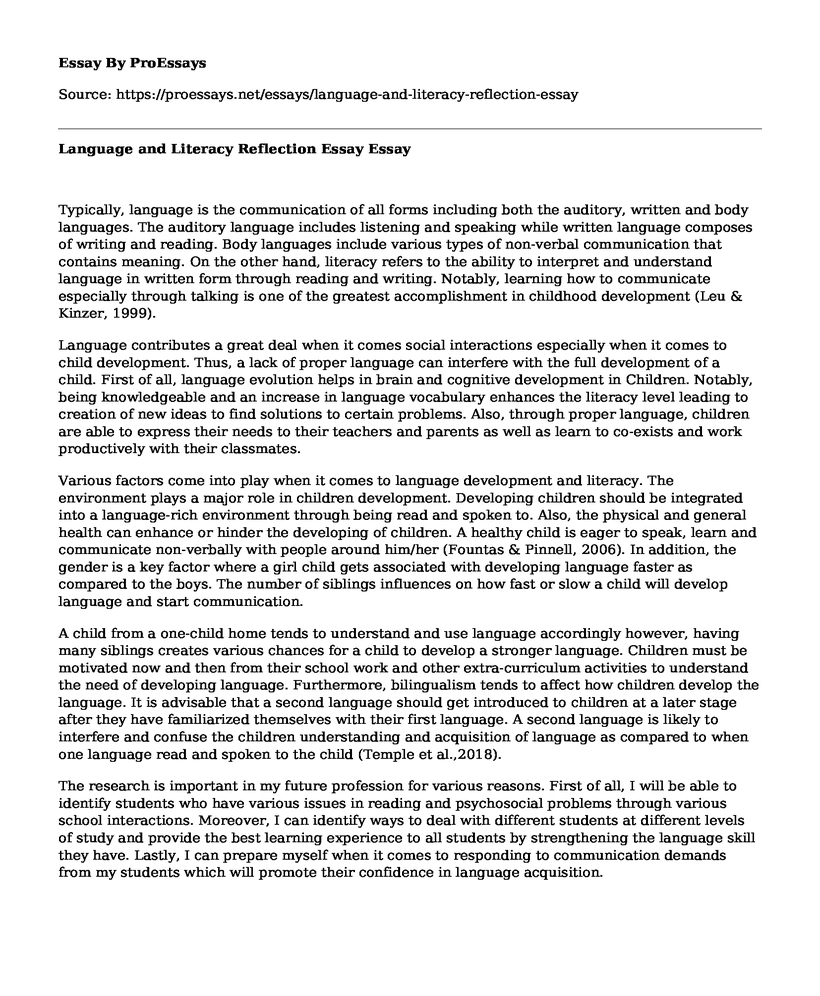Typically, language is the communication of all forms including both the auditory, written and body languages. The auditory language includes listening and speaking while written language composes of writing and reading. Body languages include various types of non-verbal communication that contains meaning. On the other hand, literacy refers to the ability to interpret and understand language in written form through reading and writing. Notably, learning how to communicate especially through talking is one of the greatest accomplishment in childhood development (Leu & Kinzer, 1999).
Language contributes a great deal when it comes social interactions especially when it comes to child development. Thus, a lack of proper language can interfere with the full development of a child. First of all, language evolution helps in brain and cognitive development in Children. Notably, being knowledgeable and an increase in language vocabulary enhances the literacy level leading to creation of new ideas to find solutions to certain problems. Also, through proper language, children are able to express their needs to their teachers and parents as well as learn to co-exists and work productively with their classmates.
Various factors come into play when it comes to language development and literacy. The environment plays a major role in children development. Developing children should be integrated into a language-rich environment through being read and spoken to. Also, the physical and general health can enhance or hinder the developing of children. A healthy child is eager to speak, learn and communicate non-verbally with people around him/her (Fountas & Pinnell, 2006). In addition, the gender is a key factor where a girl child gets associated with developing language faster as compared to the boys. The number of siblings influences on how fast or slow a child will develop language and start communication.
A child from a one-child home tends to understand and use language accordingly however, having many siblings creates various chances for a child to develop a stronger language. Children must be motivated now and then from their school work and other extra-curriculum activities to understand the need of developing language. Furthermore, bilingualism tends to affect how children develop the language. It is advisable that a second language should get introduced to children at a later stage after they have familiarized themselves with their first language. A second language is likely to interfere and confuse the children understanding and acquisition of language as compared to when one language read and spoken to the child (Temple et al.,2018).
The research is important in my future profession for various reasons. First of all, I will be able to identify students who have various issues in reading and psychosocial problems through various school interactions. Moreover, I can identify ways to deal with different students at different levels of study and provide the best learning experience to all students by strengthening the language skill they have. Lastly, I can prepare myself when it comes to responding to communication demands from my students which will promote their confidence in language acquisition.
References
Fountas, I. C., & Pinnell, G. S. (2006). Teaching for comprehending and fluency: Thinking, talking, and writing about reading, K-8. Portsmouth, NH: Heinemann.
Kidd, J. K., Pasnak, R., Gadzichowski, K. M., Gallington, D. A., McKnight, P., Boyer, C. E., & Carlson, A. (2014). Instructing first-grade children on patterning improves reading and mathematics. Early Education & Development, 25(1), 134-151.
Leu Jr, D. J., & Kinzer, C. K. (1999). Effective literacy instruction, K-8. Prentice-Hall, PO Box 11071, Des Moines, IA 50336-1071.
Naglieri, J. A., LeBuffe, P. A., & Ross, K. M. (2013). Measuring resilience in children: From theory to practice. In Handbook of resilience in children (pp. 241-259). Springer US.
Niknafs, N. (2013). The Use of Improvisation by K-8 General Music Teachers in Illinois: A Mixed Methods Study (Doctoral dissertation, Northwestern University).
Rawson, E. R. (2016). It's about them: Using developmental frameworks to create exhibitions for children (and their grown-ups). In Connecting kids to history with museum exhibitions(pp. 49-74). Routledge.
Strong Hilsmier, A., Wehby, J. H., & Falk, K. B. (2016). Reading fluency interventions for middle school students with academic and behavioral disabilities. Reading Improvement, 53(2), 53-64.
Temple, C. A., Ogle, D., Crawford, A., & Freppon, P. A. (2018). All children read: Teaching for literacy in today's diverse classrooms. Pearson.
Cite this page
Language and Literacy Reflection Essay. (2022, Jun 16). Retrieved from https://proessays.net/essays/language-and-literacy-reflection-essay
If you are the original author of this essay and no longer wish to have it published on the ProEssays website, please click below to request its removal:
- Analysis of the Biblical Text Essay
- Matt's Turning Point in Life Essay Example
- My Core Beliefs About Work
- Auntie, I'm Fighting for My Masters Degree! - Paper Example
- Essay Example on Assessing Teaching & Learning Effectiveness: Educational Research
- Free Paper Sample: My Life Development from Childhood
- Positive Aspects to Parenting - Research Paper Sample







